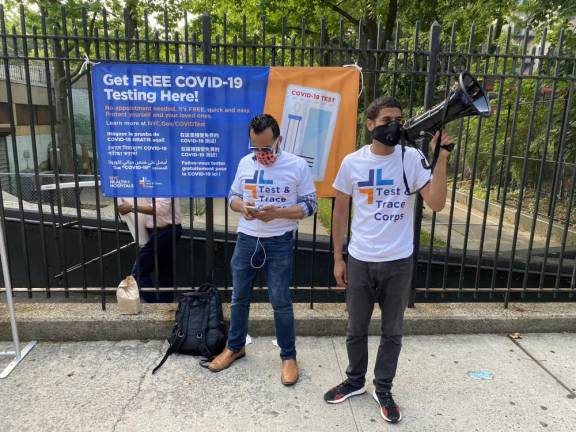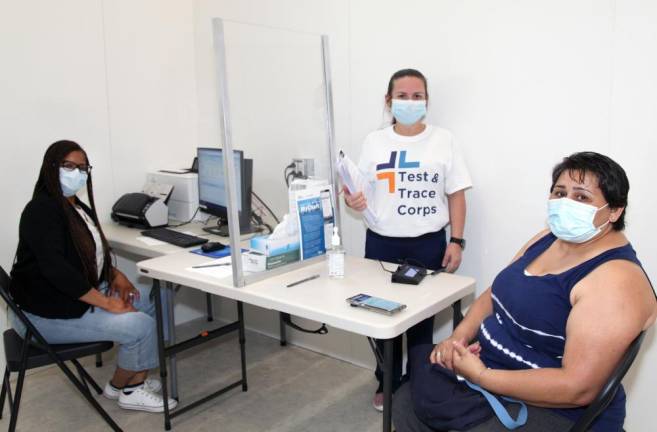The microbe hunters of New York are using every tool and tactic they can think of to seek out and contain the coronavirus.
They crunch data. They sample sewage. They yell over bullhorns to convince people to get tested. Those are just a few snapshots from the biggest public health fight the city has ever waged.
One of the biggest challenges has been to orchestrate all the elements. Early on, for example, there were so few coronavirus tests available that they had to be strictly rationed. Now there are plenty and the city is urging everyone to get tested. But as more people get tested some labs have been overwhelmed. Some test results are so slow coming back - as long as ten days - that they are useless.
Even what a city spokesperson called the “typical” time frame of three days for results is far too slow for quarantining and contact tracing to be most effective.
“This means people aren’t isolating when they’re contagious,” warned the chair of the City Council Health Committee, Mark D. Levine. “It’s a major obstacle for contact tracings. And it’s discouraging people from even getting tested. This has to be fixed ASAP.”
“We now see in New York and around the country delays in getting testing results, and we need to beat that back,” Mayor Bill de Blasio said Monday. He urged President Trump to invoke the Defense Production Act “again because we need the lab capacity, we need the chemical reagents. We need the different pieces that allow these labs to do their work and do it quickly. And that will only happen if the federal government steps up.”
Even with the bottlenecks in getting results, officials say that the contact tracing efforts are still useful, but not yet effective enough to achieve the ultimate victory, which is to drive down infections to the point where there are very few infected people around to pass on the virus. That would make it far safer to go to work, to school and to socialize.
“Powerful Lessons”
But at the moment the more immediate goal is to hold the line. With contagion out of control in other parts of the country – and worrisome hotspots even in nearby counties like Hudson, NJ – New York City is fighting a block-by-block battle to keep the number of cases in the hundreds, as now, rather than back into the thousands, as we lived through last March and April.
An immediate challenge, the mayor reported, is that infection rates are rising among young adults.
“I understand that people are just yearning to break out,” de Blasio said. “But we’ve got to keep telling everyone, particularly our younger adults, how important it is to stick to what has worked, the social distancing, the face coverings, getting tested. And so, we’re going to double down an effort to reach younger adults, digital media, messages from influencers, a night of action outreach all over the city at outdoor spots where people gather, mobile testing vans, mask giveaways. We’re going to do everything to reach younger adults, to remind them they’re not impervious.”
Individual behavior is half the battle, and there is evidence that New Yorkers, while not perfect, have done better than other communities in adopting personal protective measures.
The other half of the battle is the collective action by public health agencies. That fight is ramping up. The city’s Test and Trace program announced a goal of testing 150,000 New Yorkers for the virus last week, far more than ever before.
The Test and Trace Corps was out on Fordham Road Wednesday, bullhorn in hand, urging passersby to stop at a testing site in the St. James Recreation Center. “We’re up to 40,000 tests a day now,” the mayor claimed Friday. “That’s something a lot of other places have not been able to achieve.”
The city promises to release last week’s testing numbers on Wednesday, July 15, whether the 150,000 target has been hit or not.
Test Results
Testing, however, is only the first step in boxing in the virus, explained the city health commissioner, Dr. Oxiris Barbot. The purpose of testing is to find the virus and stop it from spreading.
Here, the challenges are still considerable. To start with, while the city has dramatically ramped up testing, the test results are coming back way too slowly, public health experts say. That means tracing contacts and isolating them falls behind from the get go.
Noah Goldberg, a furloughed reporter for the Daily News, said on Thursday that he had still not gotten his test result ten days after waiting on line for two hours at a City MD. “The test is now pretty much irrelevant,” he said.
The test and trace spokesperson, Karla Griffith, said that many private labs had been overwhelmed, in part because they were handling test from all across the country as the pandemic surged. The Mayor announced that in certain areas were there is high risk of renewed spread of the virus the city will offer rapid testing, with results within a few minutes.
The other challenge, according to public health officials, is to continue tightening the effectiveness of the tracing and isolating of potentially infected people. In its first month the Test and Trace Corps has been a bit like throwing a net with holes in it over the city. It is catching some cases, but many others slip through, according to the data it has released.
Monitoring Sewage
But test and trace is not the only tool. Public health officers are constantly crunching all sorts of data looking for locations where the virus may be spreading or the risk is high. Then they focus aggressive efforts there. The first such intense effort will begin Monday in the Tremont section of the Bronx, zip code 10457.
On a list of how hard New York neighborhoods have been hit by COVID-19, Tremont would be somewhere in the middle. Its death toll of 247 per 100,000 is far above well-to-do Manhattan neighborhoods (Upper East Side/Yorkville: 63 to 68 per 100,000) but well below the worst hit places (East New York: 708 per 100,000).
Like fire watchers looking for sparks in a forest, the health officials are trying to anticipate and spot resurgence before it can break out across the city. One technique they are using was invented to identify intestinal outbreaks by monitoring sewage. If the presence of coronavirus in sewage from a particular neighborhood starts to spike the microbe hunters know to head there.
Mayoral health advisor Jay Varma said Friday that it was “the combination of our defensive strategies, physical distancing, wearing face covers, good hygiene ... and the offensive strategies, a massive increase in the amount of testing that’s going on and testing that’s tied to identifying contacts and safely separating cases and contacts” that was, for now, the key to keeping the city safe.
“We’re up to 40,000 tests a day now. That’s something a lot of other places have not been able to achieve.” Mayor Bill de Blasio

